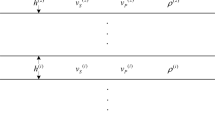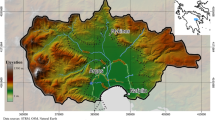Abstract
Groundwater modeling is an important tool for water resources management and aquifer remediation. However, the inherent strong heterogeneity of the subsurface and scarcity of observed data pose major challenges for groundwater flow and contaminant transport modeling. Data assimilation such as the Ensemble Smoother with Multiple Data Assimilation (ES-MDA) can be used to improve the understanding of the subsurface by integrating a variety of data into the modeling. For highly heterogeneous aquifers such as fluvial deposits, traditional data assimilation methods cannot preserve geological structures. In this work, two of the most popular deep learning methods, Variational Autoencoder (VAE) and Generative Adversarial Network (GAN), are compared for identifying geological structures using flow and transport data assimilation. Specifically, VAE and GAN are used to re-parameterize the hydraulic conductivity fields with low dimensional latent variables. The ES-MDA then is used to update the latent variables by assimilating the observed data such as hydraulic head and contaminant concentration into the model. Synthetic examples of both categorical and continuous variables are conducted to test the performance of coupling ES-MDA with VAE or GAN. The results demonstrate that the generating quality of GAN is better such that channels are generated with similar properties as in the training image, while VAE has the advantage that data assimilation is more successful in allowing better localization of the actual channels for the considered inverse problem.

















Similar content being viewed by others
References
Arjovsky M, Bottou L (2017) Towards principled methods for training generative adversarial networks. arxiv e-prints, art. arXiv preprint arXiv:1701.04862
Arjovsky M, Chintala S, Bottou L (2017) Wasserstein generative adversarial networks. In: International conference on machine learning, PMLR. pp 214–223
Bao J, Chen D, Wen F, Li H, Hua G (2017) Cvae-gan: fine-grained image generation through asymmetric training. In: Proceedings of the IEEE international conference on computer vision. pp 2745–2754
Bao J, Li L, Redoloza F (2020) Coupling ensemble smoother and deep learning with generative adversarial networks to deal with non-gaussianity in flow and transport data assimilation. J Hydrol 590:125443
Bau D, Zhu JY, Wulff J, Peebles W, Strobelt H, Zhou B, Torralba A (2019) Seeing what a gan cannot generate. In: Proceedings of the IEEE international conference on computer vision. pp 4502–4511
Canchumuni SW, Castro JD, Potratz J, Emerick AA, Pacheco MAC (2021) Recent developments combining ensemble smoother and deep generative networks for facies history matching. Comput Geosci 25:433–466
Canchumuni SW, Emerick AA, Pacheco MAC (2019) Towards a robust parameterization for conditioning facies models using deep variational autoencoders and ensemble smoother. Comput Geosci 128:87–102
Cao Z, Li L, Chen K (2018) Bridging iterative ensemble smoother and multiple-point geostatistics for better flow and transport modeling. J Hydrol 565:411–421
Certes C, de Marsily G (1991) Application of the pilot point method to the identification of aquifer transmissivities. Adv Water Resour 14:284–300
Chan S, Elsheikh AH (2017) Parametrization and generation of geological models with generative adversarial networks. arXiv preprint arXiv:1708.01810
Chen Y, Zhang D (2006) Data assimilation for transient flow in geologic formations via ensemble Kalman filter. Adv Water Resour 29:1107–1122
Creswell A, White T, Dumoulin V, Arulkumaran K, Sengupta B, Bharath AA (2018) Generative adversarial networks: an overview. IEEE Signal Process Mag 35:53–65
Danihelka I, Lakshminarayanan B, Uria B, Wierstra D, Dayan P (2017) Comparison of maximum likelihood and gan-based training of real nvps. arXiv preprint arXiv:1705.05263
de Marsily G, Lavedan G, Boucher M, Fasamino G (1984) Interpretation of interference tests in a well field using geostatistical techniques to fit the permeability distribution in a reservoir model. In: Geostatistics for natural resources characterization. NATO advanced Study Institute, pp 831–849
Emerick AA (2016) Analysis of the performance of ensemble-based assimilation of production and seismic data. J Pet Sci Eng 139:219–239
Emerick AA, Reynolds AC (2013) Ensemble smoother with multiple data assimilation. Comput Geosci 55:3–15
Evensen G (1994) Sequential data assimilation with a nonlinear quasi-geostrophic model using Monte Carlo methods to forecast error statistics. J Geophys Res Oceans 99:10143–10162
Evensen G (2003) The ensemble kalman filter: theoretical formulation and practical implementation. Ocean Dyn 53:343–367
Gómez-Hernández JJ, Journel AG (1993) Joint sequential simulation of multigaussian fields. Geostatistics troia 92. Springer, New York, pp 85–94
Goodfellow I, Pouget-Abadie J, Mirza M, Xu B, Warde-Farley D, Ozair S, Courville A, Bengio Y (2014) Generative adversarial nets. Adv Neural Inf Process Syst 2672–2680
Grover A, Dhar M, Ermon S (2018) Flow-gan: combining maximum likelihood and adversarial learning in generative models. In: Proceedings of the AAAI conference on artificial intelligence
Guardiano FB, Srivastava RM (1993) Multivariate geostatistics: beyond bivariate moments. Geostatistics troia 92. Springer, New York, pp 133–144
Harbaugh AW, Banta ER, Hill MC, McDonald MG (2000) Modflow-2000, the u. s. geological survey modular ground-water model-user guide to modularization concepts and the ground-water flow process. Open-file Report. U. S. Geological Survey. p. 134
Hou X, Shen L, Sun K, Qiu G (2017) Deep feature consistent variational autoencoder. In: 2017 IEEE winter conference on applications of computer vision (WACV), IEEE. pp 1133–1141
Huang H, He R, Sun Z, Tan T et al (2018) Introvae: introspective variational autoencoders for photographic image synthesis. Adv Neural Inf Process Syst pp 52–63
Jetchev N, Bergmann U, Vollgraf R (2016) Texture synthesis with spatial generative adversarial networks. arXiv preprint arXiv:1611.08207
Kang X, Shi X, Revil A, Cao Z, Li L, Lan T, Wu J (2019) Coupled hydrogeophysical inversion to identify non-gaussian hydraulic conductivity field by jointly assimilating geochemical and time-lapse geophysical data. J Hydrol 578:124092
Keller J, Franssen HJH, Nowak W (2021) Investigating the pilot point ensemble Kalman filter for geostatistical inversion and data assimilation. Adv Water Resour 155:104010
Kingma DP, Salimans T, Jozefowicz R, Chen X, Sutskever I, Welling M (2016) Improved variational inference with inverse autoregressive flow. Adv Neural Inf Process Syst 4743–4751
Kingma DP, Welling M (2013) Auto-encoding variational bayes. arXiv preprint arXiv:1312.6114
Kingma DP, Welling M (2019) An introduction to variational autoencoders. arXiv preprint arXiv:1906.02691
Laloy E, Hérault R, Jacques D, Linde N (2018) Training-image based geostatistical inversion using a spatial generative adversarial neural network. Water Resour Res 54:381–406
Laloy E, Hérault R, Lee J, Jacques D, Linde N (2017) Inversion using a new low-dimensional representation of complex binary geological media based on a deep neural network. Adv Water Resour 110:387–405
Laloy E, Linde N, Ruffino C, Hérault R, Gasso G, Jacques D (2019) Gradient-based deterministic inversion of geophysical data with generative adversarial networks: is it feasible? Comput Geosci 133:104333
Li L, Stetler L, Cao Z, Davis A (2018) An iterative normal-score ensemble smoother for dealing with non-gaussianity in data assimilation. J Hydrol 567:759–766
Li L, Zhou H, Gómez-Hernández JJ, Franssen HJH (2012) Jointly mapping hydraulic conductivity and porosity by assimilating concentration data via ensemble Kalman filter. J Hydrol 428:152–169
Lin Z, Khetan A, Fanti G, Oh S (2020) Pacgan: the power of two samples in generative adversarial networks. IEEE J Sel Areas Inf Theory 1:324–335
Liu Y, Gupta HV (2007) Uncertainty in hydrologic modeling: toward an integrated data assimilation framework. Water Resour Res 43
Liu Y, Weerts A, Clark M, Hendricks Franssen HJ, Kumar S, Moradkhani H, Seo DJ, Schwanenberg D, Smith P, Van Dijk A et al (2012) Advancing data assimilation in operational hydrologic forecasting: progresses, challenges, and emerging opportunities. Hydrol Earth Syst Sci 16:3863–3887
Lopez-Alvis J, Laloy E, Nguyen F, Hermans T (2021) Deep generative models in inversion: the impact of the generator’s nonlinearity and development of a new approach based on a variational autoencoder. Comput Geosci 152:104762
Ma W, Jafarpour B (2017) Conditioning multiple-point geostatistical facies simulation on nonlinear flow data using pilot points method. In: SPE Western Regional Meeting, OnePetro
Mao X, Li Q, Xie H, Lau RY, Wang Z, Paul Smolley S (2017) Least squares generative adversarial networks. In: Proceedings of the IEEE international conference on computer vision. pp 2794–2802
Mariethoz G, Renard P, Straubhaar J (2010) The direct sampling method to perform multiple-point geostatistical simulations. Water Resour Res 46
Mi L, Shen M, Zhang J (2018) A probe towards understanding gan and vae models. arXiv preprint arXiv:1812.05676
Moradkhani H, Sorooshian S, Gupta HV, Houser PR (2005) Dual state-parameter estimation of hydrological models using ensemble kalman filter. Adv Water Resour 28:135–147
Oliver DS, Cunha LB, Reynolds AC (1997) Markov chain monte carlo methods for conditioning a permeability field to pressure data. Math Geol 29:61–91
O’Malley D, Golden JK, Vesselinov VV (2019) Learning to regularize with a variational autoencoder for hydrologic inverse analysis. arXiv preprint arXiv:1906.02401
Paszke A, Gross S, Massa F, Lerer A, Bradbury J, Chanan G, Killeen T, Lin Z, Gimelshein N, Antiga L et al (2019) Pytorch: an imperative style, high-performance deep learning library. Adv Neural Inf Process Syst 32:8026–8037
Scher S, Peßenteiner S (2020) Raindisagggan-temporal disaggregation of spatial rainfall fields with generative adversarial networks
Strebelle S (2002) Conditional simulation of complex geological structures using multiple-point statistics. Math Geol 34:1–21
Todaro V, D’Oria M, Tanda MG, Gómez-Hernández JJ (2019) Ensemble smoother with multiple data assimilation for reverse flow routing. Comput Geosci 131:32–40
Turhan CG, Bilge HS (2018) Recent trends in deep generative models: a review. In: 2018 3rd international conference on computer science and engineering (UBMK), IEEE, pp 574–579
Van Leeuwen PJ, Evensen G (1996) Data assimilation and inverse methods in terms of a probabilistic formulation. Mon Weather Rev 124:2898–2913
Wen XH, Chen WH (2006) Real-time reservoir model updating using ensemble Kalman filter with confirming option. Spe J 11:431–442
Xie X, Zhang D (2010) Data assimilation for distributed hydrological catchment modeling via ensemble kalman filter. Adv Water Resour 33:678–690
Zahner T, Lochbühler T, Mariethoz G, Linde N (2016) Image synthesis with graph cuts: a fast model proposal mechanism in probabilistic inversion. Geophys J Int 204:1179–1190
Zhang J, Lin G, Li W, Wu L, Zeng L (2018) An iterative local updating ensemble smoother for estimation and uncertainty assessment of hydrologic model parameters with multimodal distributions. Water Resour Res 54:1716–1733
Zhao Y, Forouzanfar F, Reynolds AC (2017) History matching of multi-facies channelized reservoirs using es-mda with common basis dct. Comput Geosci 21:1343–1364
Zheng C, Wang PP (1999) MT3DMS: a modular three-dimensional multispecies transport model for simulation of advection, dispersion, and chemical reactions of contaminants in groundwater systems; documentation and user’s guide. Technical Report. Alabama Univ
Zhou H, Gómez-Hernández JJ, Li L (2014) Inverse methods in hydrogeology: evolution and recent trends. Adv Water Resour 63:22–37
Acknowledgements
This work has been supported through a grant from the National Science Foundation (OIA-1833069). The authors wish to thank the associate editor and two anonymous reviewers for their comments, which substantially helped to improve the final version of the manuscript.
Author information
Authors and Affiliations
Corresponding author
Rights and permissions
About this article
Cite this article
Bao, J., Li, L. & Davis, A. Variational Autoencoder or Generative Adversarial Networks? A Comparison of Two Deep Learning Methods for Flow and Transport Data Assimilation. Math Geosci 54, 1017–1042 (2022). https://doi.org/10.1007/s11004-022-10003-3
Received:
Accepted:
Published:
Issue Date:
DOI: https://doi.org/10.1007/s11004-022-10003-3




